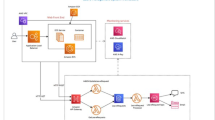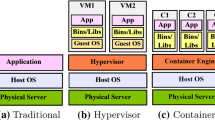Abstract
Development of modern techniques, such as virtualization, underlies new solutions to the problem of reducing energy consumption in cloud computing. However, for the infrastructure as a service providers, it would be a difficult process to guarantee energy saving. Analysis of the workload of applications shows that the average utilization of virtual machines has many fluctuations; therefore, deciding about how to control such fluctuations in virtual machines plays a significant role in improving the energy consumption of datacenters. In this study, an adaptable model called virtual machine dynamic frequency system (VMDFS) has been developed whose its innovation is monitoring the average fluctuations of workloads to vary the CPU frequency of virtual machines at runtime, dynamically. In this model, enhanced exponential moving average method is used to predict workload fluctuations, and then after calculating a smoothing coefficient for the utilization fluctuations, the coefficient is used to control the CPU frequency (or computing power) of virtual machines. The proposed model was compared with several base line approaches such as DVFS using real datasets from CoMon project (PlanetLab). The results of experiments on VMDFS show that besides the reduced service-level agreement violation by up to 43.22%, the overall energy consumption is reduced by 40.16%. In addition, the overall runtime before a host shutdown increased by 17.44% in average, while the runtime before a virtual machine migration increased by 7.2%. This also shows an overall decrease in the number of migrations.











Similar content being viewed by others
References
Barroso LA, Hölzle U (2007) The case for energy-proportional computing. IEEE Comput 40:33–37
Hyukho K, Woongsup K, Yangwoo K (2010) Experimental study to improve resource utilization and performance of cloud systems based on grid middleware. J Commun Comput 7(12):32–43
Beloglazov A, Buyya R (2012) Optimal online deterministic algorithms and adaptive heuristics for energy and performance efficient dynamic consolidation of virtual machines in cloud data centers. Concurr Comput 24:1397–1420
Laszewski G, Wang L, Younge A, He X (2009) Power-aware scheduling of virtual machines in DVFS-enabled clusters. In: Proceedings of the IEEE International Conference on Cluster Computing and Workshops
Minas L, Ellison B (2009) Energy efficiency for information technology: how to reduce power consumption in servers and data centers. Intel Press, Santa Clara
Li Z, Wang C, Lv H, Xu T (2015) Research on CPU workload prediction and balancing in cloud environment. IJHIT 8(2):159–172
Hosseinimotlagh S, Khunjush F (2014) Migration-less energy-aware task scheduling policies in cloud environments. In: 28th International Conference on Advanced Information Networking and Applications Workshops (WAINA)
Wu C-M, Chang R-S, Chan H-Y (2013) A green energy-efficient scheduling algorithm using the DVFS technique for cloud datacenters. FGCS 37:141–147
Ding Y, Qin X, Liu L, Wang T (2015) Energy efficient scheduling of virtual machines in cloud with deadline constraint. FGCS 50:62–74
Alnowiser A, Aldhahri E, Alahmadi A (2014) Enhanced weighted round robin (EWRR) scheduling with DVFS technology in cloud. In: CSCI
Veni T, Mary S (2016) Prediction model for virtual machine power consumption in cloud environments. ICRTCSE 87:122–127
Dinda PA (1999) The statistical properties of host load. Sci Program 7(3):211–229
Li J, Liu X, Zhao Z, Liu J (2015) Energy consumption prediction based on time-series models for CPU-intensive activities in the cloud. ICA3PP 9531:756–769
Beloglazov A, Buyya R, Lee YC, Zomaya A (2011) A taxonomy and survey of energy efficient data centers and cloud computing systems. Adv Comput 82:47–111
Chen Q, Grosso P, Veldt K, Laat C (2011) Profiling energy consumption of VMs for green cloud computing. In: IEEE Ninth International Conference DASC, pp 768–775
Kansal A, Zhao F, Liu J, Kothari N, Bhattacharya AA (2010) Virtual machine power metering and provisioning. In: SoCC’10, pp 39–50
Bohra A, Chaudhary V (2010) VMeter: power modelling for virtualized clouds. In: Parallel Distributed Processing, Workshops and Phd Forum (IPDPSW), 2010 IEEE International Symposium on April 2010, pp 1–8
de Lemos et al. (2013) Software engineering for self-adaptive systems: a second research roadmap. In: LNSC 7475, pp 1–32
Fan X, Weber WD, Barroso LA (2007) Power provisioning for a warehouse-sized computer. In: Proceedings of the 34th Annual International Symposium on Computer Architecture (ISCA), pp 13–23
Calheiros RN, Ranjan R, Beloglazov A, Rose C, Buyya R (2011) CloudSim: a toolkit for modeling and simulation of cloud computing environments and evaluation of resource provisioning algorithms. Softw Pract Exp 41(1):23–50
Park K, Pai VS (2006) CoMon: a mostly-scalable monitoring system for PlanetLab. ACM SIGOPS Oper Syst Rev 40(1):65–74
r-project [Internet]. The R project for statistical computing. Available: https://www.r-project.org/
Spec.org [Internet]. Standard Performance Evaluation Corporation (SPEC); 30/12/2013. Available: http://www.spec.org/power_ssj2008/results/
Beloglazov A, Buyya R (2010) Adaptive threshold-based approach for energy-efficient consolidation of virtual machines in cloud data centers. In: Proceedings of the 8th International Workshop on Middleware for Grids, Clouds and e-Science
Beloglazov A, Abawajy J, Buyya R (2012) Energy-aware resource allocation heuristics for efficient management of data centers for cloud computing. FGCS 26(5):755–768
Author information
Authors and Affiliations
Corresponding author
Appendix: Case study
Appendix: Case study
In order to show how the proposed framework works, a practical case study is presented for the runtime environment described in Table 11. The assumptions in this example are as follows: there exist six hosts, ten virtual machines, and a 1-h period of workload from PlanetLab. Table 12 shows CPU utilization in these ten virtual machines during 5-min intervals in a 1-h period. In time interval 1, the maximum computing power (frequency) of a virtual machine is used for calculating the energy. In the consequent intervals, VM CPU utilizations are estimated using enhanced exponential moving average (EEMA) prediction model. These predictions affect the computing power of each virtual machine. Table 13 shows the enhanced exponential moving average (EEMA) prediction values for the time intervals shown in Table 12.
Power and energy calculations are performed in the first 5 mins (Time 300.1) based on the maximum VM utilization. Before entering the second simulation interval, under-loaded and overloaded hosts are determined. Virtual machines are then migrated from over/under-loaded candidate hosts to appropriate target hosts using the algorithms for selecting the best VM for migration. Consumed power and energy are calculated in the second interval (time: 600.1). These calculations consider the effect of predicted power consumption, as given by enhanced exponential moving average (EEMA). Table 14 shows the calculated parameters of VMDFS evaluation metrics in the first three intervals of the 1-h simulation period in CloudSim.
Rights and permissions
About this article
Cite this article
Shojaei, K., Safi-Esfahani, F. & Ayat, S. VMDFS: virtual machine dynamic frequency scaling framework in cloud computing. J Supercomput 74, 5944–5979 (2018). https://doi.org/10.1007/s11227-018-2508-1
Published:
Issue Date:
DOI: https://doi.org/10.1007/s11227-018-2508-1




